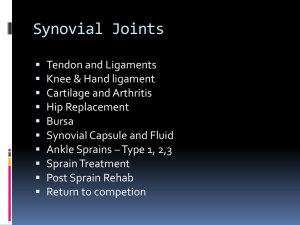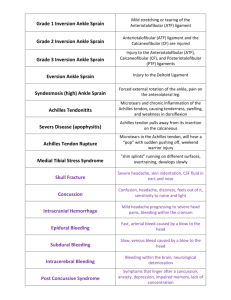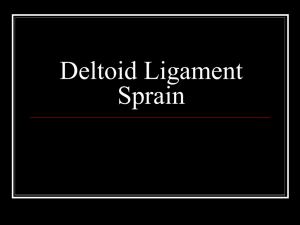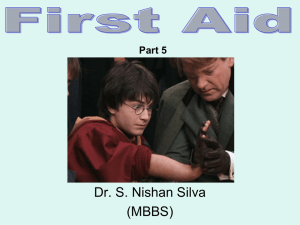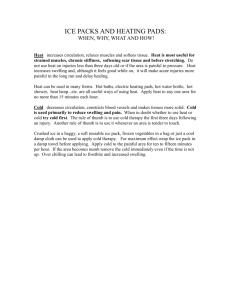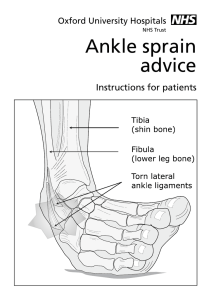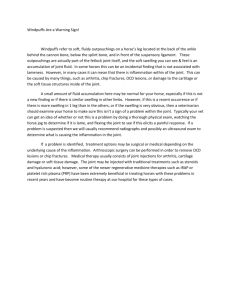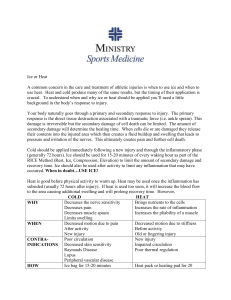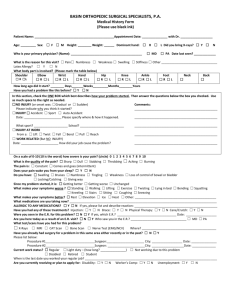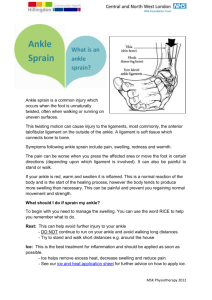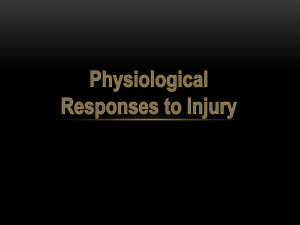Ankle Sprain Advice - Elite Physical Medicine
advertisement
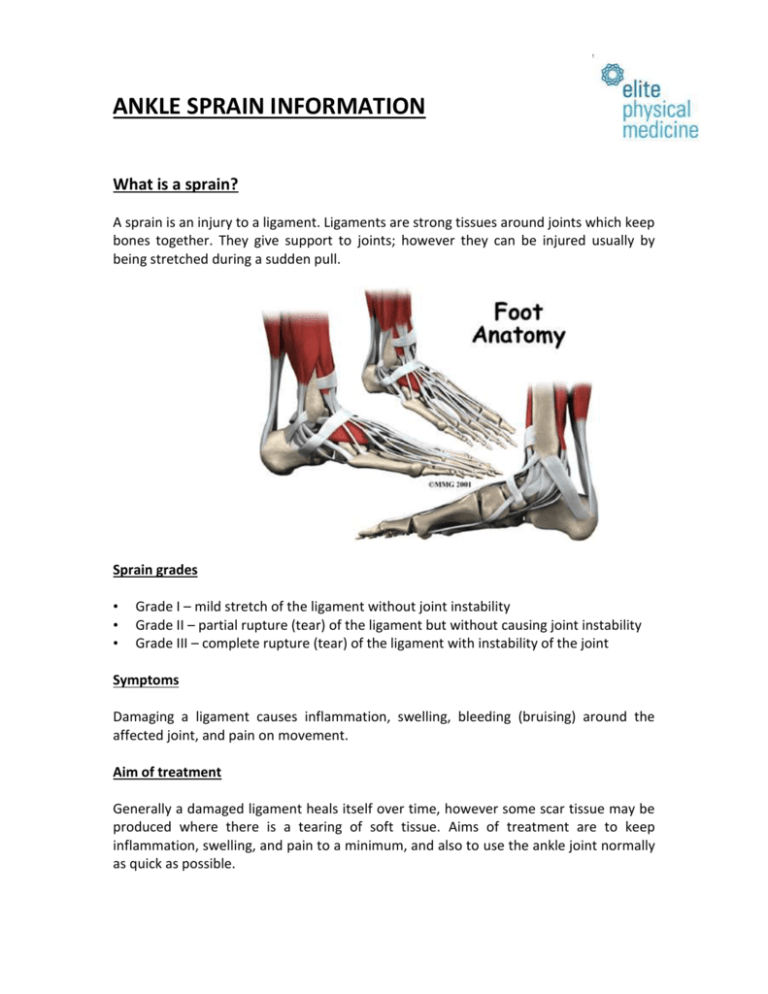
ANKLE SPRAIN INFORMATION What is a sprain? A sprain is an injury to a ligament. Ligaments are strong tissues around joints which keep bones together. They give support to joints; however they can be injured usually by being stretched during a sudden pull. Sprain grades • • • Grade I – mild stretch of the ligament without joint instability Grade II – partial rupture (tear) of the ligament but without causing joint instability Grade III – complete rupture (tear) of the ligament with instability of the joint Symptoms Damaging a ligament causes inflammation, swelling, bleeding (bruising) around the affected joint, and pain on movement. Aim of treatment Generally a damaged ligament heals itself over time, however some scar tissue may be produced where there is a tearing of soft tissue. Aims of treatment are to keep inflammation, swelling, and pain to a minimum, and also to use the ankle joint normally as quick as possible. Treatment of a sprained ankle For the first 48-72 hours: • • PRICE – Protect, Rest, Ice, Compression, Elevation Do no HARM – No Heat, Alcohol, Running, or Massage Protect = prevent further injury by using a bandage or ankle support Rest = 48-72 hours post injury rest the joint as much as possible Ice = using ice to reduce inflammation should be started as soon as possible after the injury for 10-30 minutes. Less than 10 minutes has little effect. More than 30 minutes may damage the skin. Do not put ice directly onto skin as this may cause an ice burn. The ice is believed to reduce blood flow to the damaged ligament limiting pain and inflammation. After the first application some doctors recommend re-applying ice for 15 minutes every two hours during the day. Do not leave ice on while asleep. Compression = Mild pressure that is not uncomfortable or too tight, and does not stop blood flow is ideal. Generally this is kept up for 48 hours only as it may reduce normal movement of the joint. This may vary to help to keep the swelling down and to keep the joint more comfortable. A tubular compression bandage is often used. A pharmacist will advice on the correct size. Remove before going to sleep. Elevation = Raising the ankle will help reduce swelling and make the joint more comfortable. For example sit with your foot elevated above hip level and try to sleep with your foot on a pillow. Other Treatment Keep the joint moving – do not do anything that causes pain but keeping the joint mobile will prevent the joint becoming stiff. You should not play sport or do vigorous exercise involving the ankle for at least 3-4 weeks after injury. Anti-inflammatory painkillers – These drugs are also called nonsteroidal antiinflammatory drugs (NSAIDs). They relieve pain and may also limit inflammation and swelling. There are many types and brands. Side effects sometimes occur with antiinflammatory painkillers. Stomach pain and bleeding from the stomach are the most serious. Some people with asthma, high blood pressure, kidney failure, and heart failure may not be able to take anti-inflammatory painkillers therefore always check with your GP or pharmacists before taking them to make sure they are suitable for you. There is a body of evidence to suggest that the use of anti-inflammatory painkillers is an effective treatment, however further research is required to determine the full use of anti-inflammatory painkillers following an injury. Badly ruptured ligaments – may require surgery but your doctor will assess your condition if this is necessary. However, this is not needed in most cases. Avoid HARM for 72 hours after injury. Heat = hot baths, saunas, heat packs. Heat increases blood flow to the damaged area, therefore should be avoided when inflammation is developing. However, after 72 hours no further inflammation is likely to develop therefore heat may be soothing. Alcohol = drinking alcohol can cause further bleeding, swelling and decrease healing. Running = can cause further damage. Massage = can increase bleeding and swelling into the area. However, after 72 hours gentle massage can be soothing. SEE A DOCTOR IF: • • • • • You suspect a bone may be broken or a ligament rupture You have a lot of tenderness over the bone Pain is severe Bruising is severe Symptoms and swelling do not gradually settle. Most sprains improve after a few days, and the pain gradually eases. However, the pain often takes several weeks to go completely, especially when you use the injured joint. PHYSIOTHERAPY Physiotherapy can help for more severe sprains, or if the symptoms are not settling. A physiotherapist can advise on exercises and may give heat, ultrasound, or other treatments. Aims • • • To get the joint back to full range of motion To improve strength of the surrounding muscles. The stronger the muscles the less likely a sprain will reoccur. Improve proprioception. This is the ability of your brain to sense movement and position of your body parts and joints such as your ankle. This ability enables us to know where our limbs are in space without having to look. This helps to prevent you overstretching ligaments causing further sprain.
